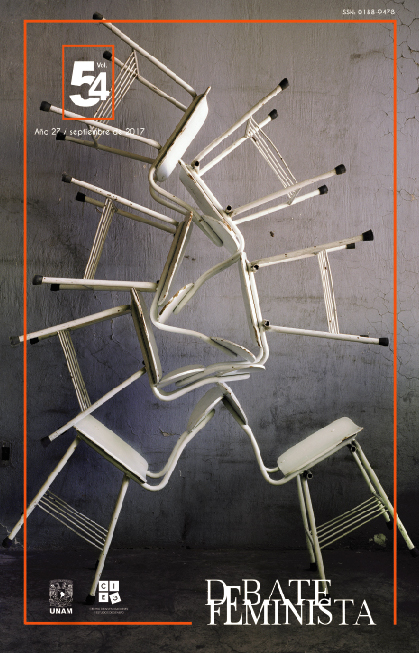The blood of the people is (also) lesbian: The artistic-political experience of Lesbians in Resistance (1995-1997)
Main Article Content
Abstract
This article analyzes the relationship between lesbian activism and political art in Buenos Aires, Argentina, in the early 90s. It focuses on the Lesbians in Resistance group, which intervened from 1995 to 1997 in the most important public square — both because of its historical-symbolic and political meaning — in the city of Buenos Aires: the Plaza de Mayo. On the basis of the historical reconstruction of the group, through the oral memory of its members, and using a feminist and queer methodology, the essay attempts to map the central elements of the group’s action: the body, the visibility and the construction of collective action using “non-durable or waste” materials. This research allowed us to highlight a little-known experience in local historiography, explore the ways lesbian militancy and artistic activism were linked during those years of neoliberal context, and create ways of recovering the LGBTTT collective memory that serve to conceive of the present.
Article Details

This work is licensed under a Creative Commons Attribution-NonCommercial-NoDerivatives 4.0 International License.
Esta es una publicación bajo la licencia Creative Commons Attribution-Non Commercial-No Derivatives 4.0 International (CC BY-NC- ND 4.0). Para mayor información sobre el uso no comercial de los contenidos que aquí aparecen, favor de consultar http://creativecommons.org/licenses/by-nc-nd/4.0/
References
Benjamin, W. (2008 [1940]). Tesis sobre la historia y otros fragmentos. México: UACM. Introducción, traducción y notas de Bolívar Echeverría.
Butler, J. (2014). Repensar la vulnerabilidad y la resistencia. Conferencia [consultado 13 Sep 2015]. Disponible en: http://www.cihuatl.pueg.unam.mx/pinakes/userdocs/assusr/A2/A22195.pdf
Cuello, N. (2014). Flujos, roces y derrames del activismo artístico en Argentina (2003-2013): Políticas sexuales y comunidades de resistencia sexoafectiva. ERRATA #12. Desobediencias sexuales. Colombia.
Davis, F. y Longoni, A. (2013). Cuidado con la pintura, en Doscientos años de Pintura Argentina, volumen III. Buenos Aires: BH.
flores, V. (2015). El sótano de San Telmo. Una Barricada proletaria para el deseo lésbico en los 70. Buenos Aires: Madreselva.
Foucault, M. (2002 [1975]). Vigilar y castigar. El nacimiento de la prisión. Buenos Aires: Siglo XXI.
Hernández Navarro, M. (2007). El archivo escotómico de la modernidad [pequeños pasos para una cartografía de la visión]. Madrid: Ayuntamiento de Alcobendas.
Hernández Navarro, M. (2012). Hacer visible el pasado: el artista como historiador (Benjaminiano). Murcia: Micromegas.
Longoni, A. (2009). Activismo artístico en la última década en Argentina: algunas acciones en torno a la segunda desaparición de Jorge Julio López. ERRATA #0. El lugar del arte en lo político. Colombia.
Longoni, A. (2010). Fotos y siluetas: dos estrategias en la representación de los desaparecidos. En E. Crenzel (Ed.), Los desaparecidos en la Argentina. Memorias, representaciones e ideas (1983-2008). Buenos Aires: Biblos.
Merleau-Ponty, M. (1964). Lo visible y lo invisible. Buenos Aires: Nueva Visión.
Pollock, G. (2013 [1988]). Visión y diferencia. Feminismo, feminidad e historia del arte. Buenos Aires: Fiordo.
Pollock, G. (1999). Differencing the canon. Oxon: Routledge.
Preciado, P. (2008). Cartografías queer: el flâneur perverso, la lesbiana topofóbica y la puta multicartográfica, o cómo hacer una cartografía ‘zorra’ con Annie Sprinkle. En J.M. Cortés (Ed.), Cartografías disidentes. Barcelona: SEACEX.
Rolnik, S. (1989). Cartografía Sentimental: transformações contemporâneas do desejo. Sao Paulo: Estação Liberdade.
Vindel, J. (2014). La vida por asalto: arte, política e historia en Argentina entre 1965 y 2001. Madrid: Brumaria 29.
VV.AA. (2014). Perder la forma humana. Una imagen sísmica de los años ‘80. Buenos Aires-Madrid: Eduntref-MNCRS.







